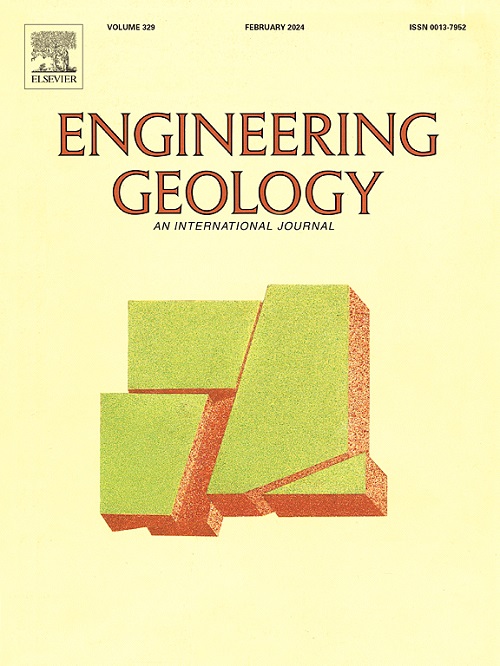Efficient Bayesian updating for deformation prediction of high rock slopes induced by excavation with monitoring data
IF 6.9
1区 工程技术
Q1 ENGINEERING, GEOLOGICAL
引用次数: 0
Abstract
This study develops an efficient Bayesian updating method with monitoring data for predicting the deformation of high rock slopes induced by excavation. The importance ranking based on random forest is introduced to identify the key rock parameters as random variables in the Bayesian updating. The surrogate models using support vector machine are constructed to approximate the physical numerical models using FLAC3D for evaluating slope deformation. A practical example involving deformation prediction of the excavated left-bank rock slope for the well-known Baihetan hydropower station in southwest China is presented. The results indicate that the developed Bayesian updating method can efficiently and accurately update the posterior distributions of rock parameters and predict the deformation of high rock slopes induced by excavation. Incorporating the monitoring data of displacement into the Bayesian updating can effectively reduce the uncertainty of rock parameters and displacement prediction. As a result, the displacement predictions made by the Bayesian updating are closer to the monitoring data than the prior displacement predictions. In addition, incorporating more monitoring data of displacement from the previous excavation stages produces more accurate displacement predictions for subsequent excavation stages.
利用监测数据对开挖引起的高岩层边坡变形进行高效贝叶斯更新预测
本研究利用监测数据开发了一种高效的贝叶斯更新方法,用于预测开挖引起的高岩层边坡变形。在贝叶斯更新中,引入了基于随机森林的重要性排序,以确定作为随机变量的关键岩石参数。使用支持向量机构建了代用模型,以近似使用 FLAC3D 评估边坡变形的物理数值模型。以中国西南著名的白鹤滩水电站开挖左岸岩石边坡的变形预测为例进行了介绍。结果表明,所开发的贝叶斯更新方法能够高效、准确地更新岩石参数的后验分布,并预测开挖引起的高岩石边坡变形。将位移监测数据纳入贝叶斯更新方法,可有效降低岩石参数和位移预测的不确定性。因此,贝叶斯更新法得出的位移预测结果比先前的位移预测结果更接近监测数据。此外,将更多前一挖掘阶段的位移监测数据纳入贝叶斯更新方法,可为后续挖掘阶段提供更准确的位移预测。
本文章由计算机程序翻译,如有差异,请以英文原文为准。
求助全文
约1分钟内获得全文
求助全文
来源期刊

Engineering Geology
地学-地球科学综合
CiteScore
13.70
自引率
12.20%
发文量
327
审稿时长
5.6 months
期刊介绍:
Engineering Geology, an international interdisciplinary journal, serves as a bridge between earth sciences and engineering, focusing on geological and geotechnical engineering. It welcomes studies with relevance to engineering, environmental concerns, and safety, catering to engineering geologists with backgrounds in geology or civil/mining engineering. Topics include applied geomorphology, structural geology, geophysics, geochemistry, environmental geology, hydrogeology, land use planning, natural hazards, remote sensing, soil and rock mechanics, and applied geotechnical engineering. The journal provides a platform for research at the intersection of geology and engineering disciplines.
 求助内容:
求助内容: 应助结果提醒方式:
应助结果提醒方式:


